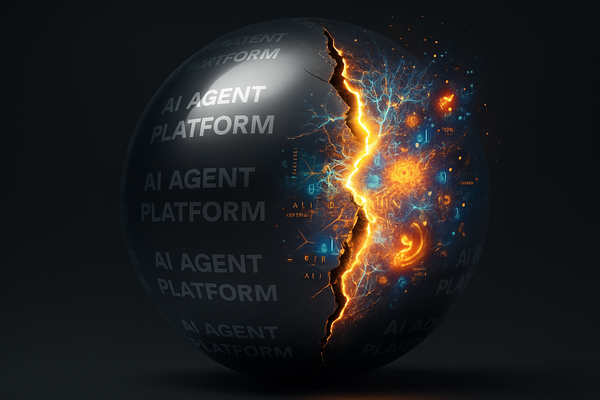Riding a Bicycle in the Age of Rocket Ships: Unlocking AI’s Full Potential
The AI Disconnect: 78% of leaders see AI’s value, but only 19% focus on transformation. Avoid the efficiency trap by aligning AI to strategy, strengthening data infrastructure, and building AI-fluent teams. Embrace AI as a force for transformation, not just quick wins.

The Great AI Disconnect
On a crisp morning in Silicon Valley, a CEO stares at the latest AI implementation report on her desk. Like many of her peers, she's caught in what might be the defining paradox of our time: while 78% of business leaders express confidence in capturing AI's value, only 19% are actually focusing on its transformative potential. This stark disconnect between confidence and strategic action represents a critical challenge facing modern business leadership.
"The gap between AI ambition and execution is not just a metric - it's a warning sign for the future of business leadership."
The Seductive Pull of Quick Wins
The allure of immediate results is powerful. Across boardrooms and executive suites, leaders are falling into what industry experts call the "efficiency trap" - prioritizing quick operational gains over long-term transformation. It's akin to using a quantum computer to run a calculator app - technically effective, but profoundly limiting.
Consider the experience of a Fortune 500 manufacturer who recently implemented AI for quality control. While the immediate cost savings were impressive - reducing defects by 23% - the company missed the bigger opportunity to reimagine their entire production process. This pattern repeats across industries, where the pursuit of quick wins often overshadows transformative possibilities.
"Using AI solely for efficiency is like using a Ferrari to deliver newspapers - it works, but misses the point entirely."
Digital Natives: The New North Star
What separates the leaders from the followers in the AI revolution? Digital-native companies are showing the way, demonstrating three critical success factors:
- Strategic Clarity: These companies don't just deploy AI - they weave it into their organizational DNA, with clear roadmaps aligned to business objectives.
- Data Mastery: They treat data as a strategic asset, maintaining robust infrastructures that can support advanced AI applications.
- Talent Innovation: Beyond just hiring AI experts, they're creating entire ecosystems of AI-fluent professionals across all departments.
The Human Element: The Missing Piece of the AI Puzzle
Perhaps the most overlooked aspect of AI transformation is its human impact. Recent research reveals a concerning trend: widespread anxiety about AI-driven job displacement is creating significant resistance to adoption. Progressive organizations are addressing this through:
- Transparent communication about AI's role and impact
- Active engagement with employees at all levels
- Comprehensive upskilling programs
- Clear career progression paths in an AI-enhanced workplace
"The most successful AI implementations aren't just about technology - they're about people."
Breaking Through Implementation Barriers
The path to AI transformation isn't without its obstacles. Deloitte's groundbreaking report identifies several critical barriers:
- Regulatory uncertainty (cited by 38% of executives)
- Risk management concerns
- Integration challenges with existing systems
- Talent gaps in key areas
These challenges are creating what experts call an "AI speed limit," with most organizations struggling to scale their AI initiatives effectively.
The Strategic Imperative: A Five-Point Framework
To bridge the gap between AI potential and reality, organizations need a structured approach:
- Goal Alignment: Every AI initiative must directly support core business objectives
- Data Readiness: Establish robust data governance and infrastructure
- Cultural Transformation: Build AI literacy across the organization
- Experimental Mindset: Use pilots to test and refine approaches
- Governance Framework: Establish clear guidelines for AI development and deployment
The Economic Evolution of AI
Looking ahead to 2025, industry analysts predict significant shifts in the AI landscape. The cost of AI inference is expected to decrease dramatically, while new architectural approaches like state-space models and liquid neural networks are emerging. These developments suggest that organizations need to prepare for a future where AI capabilities are both more powerful and more accessible.
"Tomorrow's competitive advantage won't come from having AI, but from how strategically you deploy it."
From Spectators to Architects of Change
The message for business leaders is clear: the time for passive observation is over. Success in the AI era requires a fundamental shift from being mere observers to becoming architects of transformation. This means:
- Developing comprehensive AI strategies aligned with long-term business goals
- Investing in organizational capabilities and talent
- Creating cultures that embrace AI-driven innovation
- Building robust governance frameworks that enable rather than restrict
The Path Forward
The choice for business leaders is clear: embrace AI's transformative potential or risk being left behind. The organizations that will thrive are those that move beyond surface-level implementations to embrace AI as a catalyst for fundamental business transformation. The future belongs to those who can bridge the gap between AI curiosity and strategic implementation, creating lasting value in an AI-driven world.




